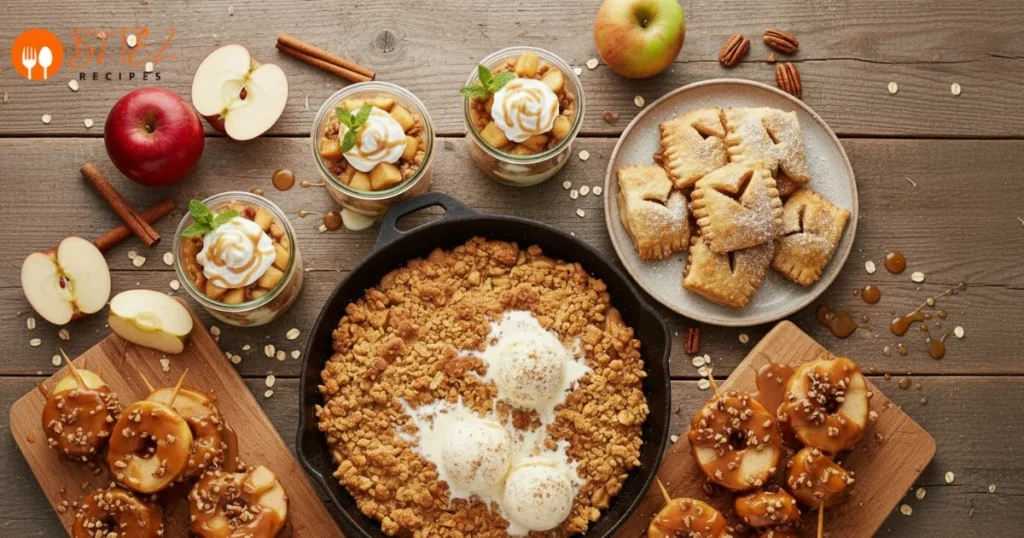Need a rich and flavorful medium rare steak? This guide teaches you how to grill the perfect steak. You will get the appropriate steak temperature and know how to steer clear of errors. Hello, tasty home meals, just as good as when eating out.

Close-up shot of a medium rare steak cooking on a cast iron pan, golden brown on the outside and a pink, juicy center. Fresh sprigs of thyme are on the side, along with melted butter. It’s an appetizing setup. The light is warm and welcoming, providing a soft sheen to the setting. The background is not clear, ensuring all attention remains on the stunning, well-cooked steak. This photo, with the Bitez Recipes logo, will be a visually appealing guide to getting the perfect medium rare steak.
Key Takeaways
- Master steak temperature to achieve the perfect medium rare steak doneness.
- Find techniques in this steak cooking guide for repeatable results.
- Don’t overcook by knowing visual signs and internal steak temperature.
- Find out why medium rare steak is the ultimate combination of flavor and tenderness.
- Essential tools such as a meat thermometer guarantee success every time.
Understanding What Constitutes a Medium Rare Steak
Knowing medium rare is important. It’s an ideal combination of softness and flavor. It’s a favorite of chefs as well as home cooks.
Temperature Range for Medium Rare
The key to medium rare steak doneness lies in precision. A thermometer ensures the steak internal temperature reaches 135 degrees Fahrenheit. This ensures the meat is juicy but not overly hard.
Remember, remove steaks from heat 5°F short of when you’d like them. The residual heat will cook them to perfection.
Visual Indicators of Perfectly Cooked Medium Rare
- Center is warm red with a pink shade towards the edges
- Outer crust forms a golden-brown sear
- When pressed, it is springy but soft to the touch
Why Medium Rare is the “Sweet Spot”
At 135°F, the meat becomes just firm enough. It retains its juices nicely. This medium rare temperature prevents the grayish appearance of overcooking.
The surface receives rich flavors from the Maillard reaction. The inside remains juicy. Cuts such as ribeye or filet are ideal here, revealing beef’s real taste.
Choosing the Right Cut of Meat
Selecting the ideal cut begins with knowing the best steak cuts for medium rare. Ribeye, strip steak, and filet mignon are high recommendations for taste and tenderness. Each of them has unique characteristics.
- Ribeye: It’s marbled with fat for rich, buttery juiciness. Opt for USDA Prime for the richest flavor.
- Strip Steak: It has a firm texture and strong beef flavor. It’s ideal for those who prefer a combination of tenderness and flavor.
- Filet Mignon: It is lean and tender, perfect for those who prefer mild, subtle beef flavors.
knowing something about beef grades is important as well. USDA Prime is top-notch strip steak with lots of marbling. Choice is a good value. Don’t go for Select for medium rare unless you’re on a tight budget. Go for cuts 1–1.5 inches thick for even cooking.
“Fat distribution is flavor’s secret weapon. Marbling keeps meat juicy during high heat,” explains the USDA’s beef grading guidelines.
Lost at the butcher? Request ribeye with apparent marbling or filet mignon for lean meats. Grass-fed is fine as well, but cook them a few degrees lower to prevent dryness. On special occasions, splurge on quality. But don’t ignore mid-range best steak cuts for everyday dinners.
Essential Tools for Cooking the Perfect Steak
Each kitchen appliance has its purpose, yet some are particularly notable for steak supremacy. These steak cooking tools reinforce technique. They assist whether you’re a professional chef or weeknight grill master.
Trustworthy Meat Thermometer Choices
A meat thermometer is your greatest friend. Professional chefs swear by instant-read thermometers such as the Thermapen or Lavatools Javelin. They prefer 130°F (54°C) for medium rare.
Digital ones provide instant readings. Wireless ones allow you to check from a distance. Inexpensive ones such as the CDN Super-Fast cost less than $20.
The Perfect Pan Choice
Select a pan that retains heat without sticking. A cast iron skillet by Lodge or Staub is excellent. It sears well and holds heat.
Carbon steel pans (such as the All-Clad D3) are lighter but very durable. Do not use non-stick pans; they can’t be heated to the high temperatures required for a good crust.
Other Tools That Assist
- Tongs for steak flipping without piercing juices out
- Timer app (programmed at 3-minute sears) to prevent overcooking
- Cast-iron skillet weights for additional pressure when searing
- Herb brushes for basting butter and aromatics
You don’t have to have all gadgets at the same time. Begin with a good instant-read thermometer and heavy pan. Then, add to your tool arsenal as you become more confident. Each tool has its purpose, but everything begins with these essentials.
Preparation of Your Steak Prior to Cooking
Steak preparation turns an ordinary cut into an unforgettable meal. These simple steps make each bite extraordinary, both for professionals and novices alike. Let us examine what one should do prior to cooking commencement.
Bringing Steak to Room Temperature
Place your steak at room temperature for 30-60 minutes prior to cooking. It will cook more evenly and brown nicely. Always cook it within 2 hours to ensure it remains safe. Thin steaks have 30 minutes, and thicker ones such as ribeye may have an hour.
Seasoning Techniques
Salt and pepper is traditional, but feel free to experiment. Here is how to season correctly:
- Pat the steak dry beforehand to ensure the seasoning adheres better.
- Apply plenty of coarse salt and freshly ground pepper.
- Experiment with different seasoning mixes such as garlic powder or smoked paprika for added flavor.
Let the seasoned steak rest for 10 minutes to allow the flavors to combine.
Dry Brining: Is the Extra Time Worth It?
Dry brining is coating the steak in salt and allowing it to rest for 1-24 hours. It tenderizes the meat by drawing moisture in. A 12-hour brine is perfect for tougher steaks like flank steak. Pro tip: Pat dry before searing for a nice golden crust.
“Dry brining is like treating your steak to a spa day before grilling,” says Chef Marco Lopez.
Select the approach that suits your time. Even a salt-and-pepper steak can be fantastic with proper attention. Your time and taste will create the ideal dish.
The Science Behind a Juicy Medium Rare Steak
Steak juiciness begins at the molecular level. When meat is cooked, proteins such as myosin tighten and go through protein denaturation. Moisture gets pushed out during this process. Overcooking or overheating will result in your steak drying out.
The magic happens at 130–135°F. That is the spot where proteins just stiffen up. They trap juices without cooking them too long.
- Maillard reaction: The brown color on the surface of the steak is not appearance—chemistry. It produces hundreds of flavor molecules.
- Fat distribution: Intramuscular fats melt at medium temperatures. They baste the steak internally. That’s why marbled steaks such as ribeye remain juicy for longer.
Carryover cooking also counts. After being removed from heat, internal temperatures increase 5–10°F. This is because residual heat finds its way inward. Pull that steak at 125°F to reach 130°F resting.
Science isn’t only for the lab—it’s your secret power tool for dependable results. The next time you enjoy a medium rare steak, be sure to thank protein denaturation for the texture. Thank the Maillard reaction for the nice crust. Now you know the steak science behind each bite.
Step-by-Step Guide to Stovetop Medium Rare Steak Cooking
Master cooking stovetop steak easily. Either you’re cooking indoors with a grill or preparing pan seared steak, see these steps for a delicious meal.
Ideal Sear: Timing and Technique
Begin by preheating a cast-iron skillet to medium-high heat until near smoking. Add 1 tablespoon of oil such as avocado or grapeseed. Position the steak but don’t stir it for 1-2 minutes to achieve a crust.
For a 1-inch steak, sear 3-4 minutes per side. Then, finish it in the oven if necessary.

coarse black pepper and freshly cracked black pepper, forming a delicious crust on top. Glistening drops of rendered fat catch the warm light, highlighting the tender, pink interior of the steak. The skillet sits on a sleek, minimalist stovetop in a bright, clean kitchen, with Bitez Recipes branding visible in the distance. The image conveys a feeling of culinary skill and the flawless execution of a timeless stovetop cooking method.
- Pat the steak dry with paper towels beforehand.
- Season liberally with kosher salt and freshly ground pepper.
- Don’t overcrowd the pan—cook steaks individually if necessary.
Steak Flipping Technique
Curious when to flip? Follow this guide:
| Method | Time per flip | Best For |
|---|---|---|
| Single Flip | 3-4 minutes per side | Even browning on both sides |
| Multiple Flips | Every 60-90 seconds | Thicker cuts or uneven pans |
Butter Basting for Added Flavor
Add 1-2 tablespoons of butter to the pan in the final 2 minutes. Stir in minced garlic and fresh herbs such as thyme. Tilt the pan and spoon melted butter over the steak. This is the steak flipping method and butter basting for added flavor.
“Basting adds richness without drying the meat,” says Chef Amanda Lee of The Steak Journal.
Let the steak sit 5-10 minutes before slicing it against the grain. Enjoy your beautifully prepared pan seared steak!
Grilling the Ideal Medium Rare Steak
Learning how to prepare grilled medium rare steak starts with your grill configuration. For charcoal grilling, create a two-zone fire. It is a hot direct zone and cooler indirect zone. Gas grillers should preheat to grilling temperature of 450–500°F. They can achieve zones by varying burner settings. Always preheat grates first—high heat and oil prevent sticking.
Place thicker cuts in indirect area initially. Next, sear them on direct heat. An instant-read thermometer is crucial—130–135°F is gas grill steak perfection. For charcoal, observe smoke and color to gauge readiness.
- Gas grills: Sear 2–3 minutes per side, then finish indirectly.
- Charcoal: Turn steaks every 2–3 minutes to distribute heat evenly.
Prevent flare-ups by removing excess fat and having a spray bottle on hand. The “reverse sear” technique (explained below) is effective here as well—start low and slow, finish with a high-heat sear.
Let your steak rest 5–10 minutes once cooked. Allow juices to redistribute prior to serving. Charcoal or gas, patience and accuracy make even the most basic grill a steakhouse-quality appliance. Now fire up, flip intelligently, and enjoy that medium rare utopia.
Utilizing the Reverse Sear Method to Achieve Consistently Flawless Results
Master the reverse sear technique, a pro secret to even cooking and ideal doneness. It begins with low and slow cooking. A high-heat sear creates a crispy crust and tender meat afterward.

the pink, tender center. In the middle distance, a cast-iron pan rests on a wooden cutting board, surrounded by some fresh sprigs of thyme and a dollop of butter. In the background is the Bitez Recipes logo, speaking to the culinary know-how that goes into this drool-worthy presentation. The photo gets to the heart of the reverse sear technique, providing a perfectly perfect steak every time.
Step-by-Step Reverse Sear Process
- Preheat oven to 225–275°F. Position steak on wire rack over baking sheet.
- Cook to internal temperature of 110–120°F (30–60 mins for 1.5-inch steak).
- Transfer to smoking-hot cast-iron skillet or grill for 30 seconds per side to sear.
- Rest 5–10 minutes before slicing against the grain.
Advantages of the Reverse Sear Method
- Removes overcooked edges—uniform cooking from center to edge
- Preserves juices for perfect doneness without guessing
- Functional on stoves or grills—no specialized equipment required
Chefs love this technique for its reliability. It will be longer than the regular method, but the result is worth waiting for. Perfect for special dinners when you have the time!
Common Mistakes to Steer Clear of When Cooking Medium Rare Steak
Even the best chefs mess up occasionally. Knowing these steak cooking tips prevents common errors. In this manner, you can prepare restaurant steaks every time.
Overcrowding the Pan
Placing too many steaks in a pan causes them to steam rather than sear. Here’s how you can steer clear of it:
- Utilize a large skillet and have 2 inches of space between steaks
- Cook by batches if necessary
Disregarding Resting Time
Not allowing the steak to rest allows juices to escape. Allow it to rest for 5-10 minutes after cooking:
| Thickness | Rest Time |
|---|---|
| 1 inch | 5 minutes |
| 1.5 inches | 7-8 minutes |
| 2 inches | 10 minutes |
Cutting Too Soon
Cutting the steak immediately after cooking releases juices. Wait 5 minutes before cutting.
Other common mistakes:
- Not drying steaks before searing
- Using a cold pan
- Flipping more than once
Pro tip: Begin with a dry, hot pan. These steak cooking tips will ensure every meal is a success!
How to Check if Your Steak is Medium Rare Without a Thermometer
It teaches you to feel the doneness. Press your finger into the steak. It should feel the same as the soft part of your palm when you press thumb to index finger. That’s how you’ll know it’s medium rare. Practicing the finger test doneness frequently will make you better at it.

Recipes logo in the lower right-hand corner. The pieces of steak are laid in a grid pattern, each one representing a different degree of redness, from red to well done. The lighting is mild and directional, creating light shadows that highlight the texture of the meat. The background is minimalist and clean, and the steak and the hand remain the main focus. The overall atmosphere is educational and informative, offering a visual aid to determine steak doneness by touch.
- Touch Test Steps:
- Gently press the steak with your fingertip.
- Compare firmness with the softness of your hand when thumb touches index finger.
- Slight spring back indicates it’s near medium rare.
And inspect the color of the steak. A medium rare steak has a red core in the center. The outermost parts turn into grayish-brown but not the center, which remains red. Steaks that are thinly cut may not bulge that much as bigger steaks do.
“The best chefs learn to trust their hands and eyes as much as tools.”
Don’t forget to test the juices. Medium rare steak will have a small amount of clear liquid. Thicker steaks take longer, so cook them for 3-4 minutes on each side for 1.5-inch steaks. Use a thermometer to see if you’re ready yet. With time, you’ll instinctively know without any tools.
Serving Suggestions and Wine Pairings for Your Perfect Steak
After cooking your steak just right, add some special touches. Choose the right sides and wine to make it unforgettable.
Classic Side Dishes That Complement Steak
Match your steak’s flavor with creamy mashed potatoes or roasted asparagus. A crisp salad is also great. For something different, try roasted sweet potatoes or quinoa pilaf. These sides let the steak shine.
Wine Selection Guidelines
| Wine Type | Pairing Notes | Price Range |
|---|---|---|
| Cabernet Sauvignon | Full-bodied, pairs with bold cuts | $20–$50 |
| Malbec | Smooth tannins, great with thicker steaks | $15–$35 |
| Alternatives | Chardonnay or dry rosé for lighter options | $12–$40 |
Compound Butter Recipes to Take Your Steak to the Next Level
- Garlic-Herb Butter: Combine softened butter with minced garlic, parsley, and salt. Roll into a log, refrigerate, and slice onto hot steak.
- Blue Cheese Butter: Combine blue cheese with butter and a splash of cream. Ideal for tenderloin or ribeye.
- Chipotle Butter: Add smoked chipotle peppers and lime juice for a smoky flavor.
For steak presentation, place the steak on a hot plate. Top it with melted compound butter. Garnish with herbs or edible flowers for an elegant appearance.
Conclusion
Practice, patience, and skill are necessary to learn to prepare the ideal medium rare steak. Stovetop, grill, or reverse sear can be used. Every method makes you improve your steak-cooking skills.
The beef temperature guide ensures that your steak remains in the optimal 130°F–135°F range. This is when the steak remains juicy and rich in flavor. Even experienced cooks continue to learn and improve.
Experiment with new things such as rosemary garlic butter or red wine along with your steak. Monitor your cooking and try making small modifications. This will make you improve with every attempt.
It is not merely the equipment or how hot the grill is. It is about having faith in yourself and the process of cooking. Now, your turn to cook and share your triumphs.
What is the next new method you will attempt? Each time you cook a wonderful steak, it indicates that you’ve had practice. Continue to improve, and your next meal will be incredible. Bon appétit!
FAQ
What is the best temperature for medium rare steak?
The best temperature for a medium rare steak is 130°F to 135°F. This makes the steak tender and juicy. It also warms the center and makes it red.
How do I know if my steak is medium rare when I don’t have a thermometer?
Use the touch test. Compare the firmness of the steak to the soft spot between your thumb and forefinger. It should feel the same.
What type of steak is best to cook medium rare?
Ribeye, New York strip, filet mignon, and T-bone steaks are excellent. They are flavorful and tender when cooked to perfection.
Do I need to season my steak before I cook it?
Yes, seasoning is the way to go! Salt and pepper are fine, but experiment with garlic, herbs, or butters as well. It’s all about flavor.
What is dry brining and how will it benefit my steak?
Dry brining salts the steak in advance. It keeps the steak juicy and flavorful. It requires 1 hour to 24 hours prior to cooking.
Can I use a regular pan instead of a cast iron skillet?
Yes, you can use stainless steel or carbon steel pans as well. Just ensure they’re hot for even searing.
How long do I need to let my steak rest after cooking?
Let it sit for 5 to 10 minutes. This tenderizes and flavors the steak.
What are some good side dishes to serve with a medium rare steak?
Use mashed potatoes, creamed spinach, and asparagus grilled. Or change it up with roasted vegetables or a salad.
What wines go well with medium rare steak?
Select strong red wines such as Cabernet Sauvignon, Malbec, and Syrah. They complement the flavors of the steak. For white, a full-bodied Chardonnay is also suitable.
What are some common pitfalls I should steer clear of while cooking steak?
Don’t overcrowd the pan, not resting the steak, and cutting it prematurely. These errors can destroy the crust and taste.








